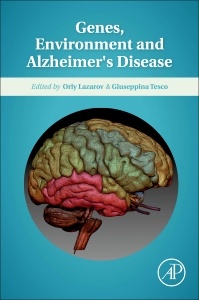Description
Genes, Environment and Alzheimer's Disease
Coordinators: Lazarov Orly, Tesco Giuseppina
Language: English
Subjects for Genes, Environment and Alzheimer's Disease:
Keywords
AICD; Acetylation; Adult neurogenesis; Aggregation; Aging; Alzheimer's disease; Amyloid; Amyloid-beta; Amyloid-β; ApoE; Axonal transport; Aβ; Beta-amyloid; Bilingualism; Biomarkers; CREB; Cerebrovascular system; Cholesterol metabolism; Cognition; Cognitive decline; Cognitive reserve; Concussion; Cyclic nucleotide; Dentate gyrus; Diabetes; Diffuse axonal injury; Early detection; Education; Endothelial cells; Enriched environment; Episodic memory; Exercise; Functional endophenotype; Glucose metabolism; HAT; HDAC; Hippocampus; Histone; Immunotherapy; Inflammation; Innate immunity; Insulin; Insulin signaling; Interleukin; Ischemia; Knockout mice; Learning; Lifestyle; MAPK; Macrophage; Memory; Memory consolidation; Microbiome; Microglia; Middle cerebral artery occlusion; Mitochondria functions; NO; Neurite outgrowth; Neurogenesis; Neuroinflammation; Neuron; Neuroplasticity; Neuropsychology; Neurovascular unit; Nutrition; Phagocytosis; Phosphorylation; Processing; Protein degradation; Secretase; Sleep deprivation; Soluble-APP-alpha; Stroke; Synaptic dysfunction; Synaptic plasticity; Therapeutics; Therapy; Transgenic mice; Traumatic brain injury; Tumor necrosis factor; Vascular cognitive impairment; Vasculature
448 p. · 15x22.8 cm · Hardback
Description
/li>Contents
/li>Readership
/li>Biography
/li>Comment
/li>
Genes, Environment and Alzheimer's Disease discusses the role that activities such as exercise can play in cardiovascular health, while also highlighting the fact that the last 10 years have brought great discoveries in the strong environmental component of brain disorders, neurodegeneration, and cognitive decline.
It is now clear that brain insult is an environmental risk factor for AD, while on the other hand, lifestyle components such as exercise and level of education may play a protective role, delaying the onset and/or severity of the disease. Evidence from experiments in rodent models of Alzheimer?s disease contributes major insight into the molecular mechanisms by which the environment plays its role in AD. Additionally, there are diseases related to lifestyle that may lead to AD. This volume reviews new discoveries related to all these factors, serving as a translational tool for clinicians and researchers interested in genetic and environmental risk factors for the disease.
1. What Is Cognition? Molecular Mechanisms of Learning and Memory Daniela Puzzo, Jole Fiorito, Rosita Purgatorio, Walter Gulisano, Agostino Palmeri, Ottavio Arancio and Russell Nicholls 2. When Cognitive Decline Becomes Pathology: From Normal Aging to Alzheimer’s Disease Eliezer Masliah and David P. Salmon 3. Adult Neurogenesis and Cognitive Function Keri Martinowich and Robert J. Schloesser
SECTION I. Genetic Forms of AD 4. APP and Cognition Robert Marr 5. FAD Signaling, PS and Cognition Li Gan
SECTION II. Environmental Factors 6. The effect of APOE genotype on amyloid-independent mechanisms Guojun Bu 7. Lifestyle and AD Orly Lazarov 8. Bace and Cognition Giuseppina Tesco 9. Traumatic Brain Injury and Rationale for a Neuropsychological Diagnosis of Diffuse Axonal Injury Douglas H. Smith 10. Alzheimer's Disease and the Sleep-Wake Cycle Adam W. Bero and Li-Huei Tsai 11. Stroke, Cognitive Function and Alzheimer’s Disease Katherine A. Jackman 12. Cerebral innate immunity: a new conceptual framework for Alzheimer’s David Gate and Terrence Town 13. Type 2 Diabetes and AD Marcelo Bonini
Basic and clinical neuroscientists working on AD, cognitive decline and dementia
Dr. Giuseppina Tesco is an Associate Professor (with tenure) at Tufts University. She received her MD and PhD from the University of Florence, Italy. She also completed her residency in Neurology at the University of Florence. In 1995, she was awarded a prestigious Fogarty Postdoctoral Visiting Fellow award to study the role of potassium channels in the learning and memory process and in Alzheimer’s disease at NINDS. In 1997, she joined the Department of Neurology at Massachusetts General Hospital and Harvard Medical School where she became Assistant Professor. In 2009 Dr. Tesco accepted a Faculty position at Tufts University. Her research focuses on Alzheimer’s Disease (AD). She identified a novel mechanism that regulates BACE1 levels and activity via the trafficking molecules GGA1 and GGA3 (golgi-localized gamma-ear-containing ARF binding protein 1-3). She was the first one to demonstrate that BACE1 is normally degraded in the lysosomes and that caspase-
- Provides the first volume to link genetic and environmental risk factors for Alzheimer’s disease and dementia
- Aids researchers and clinicians in understanding the basic mechanisms of Alzheimer’s disease and cognitive decline
- Brings the basic science and clinical perspectives together in a single volume, facilitating translational possibilities
- Includes a range of molecular to behavioral components assembled into a single volume that creates an excellent resource for basic and clinical neuroscientists
These books may interest you

Inflammation and Oxidative Stress in Neurological DisordersEffect of Lifestyle, Genes, and Age 158.24 €

Inflammation and Oxidative Stress in Neurological DisordersEffect of Lifestyle, Genes, and Age 158.24 €

Presenilins and Alzheimer's Disease 105.49 €

